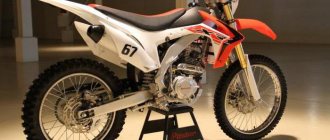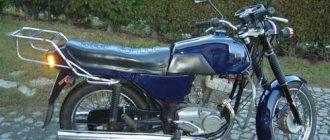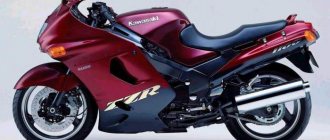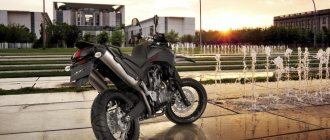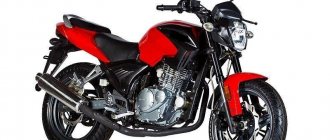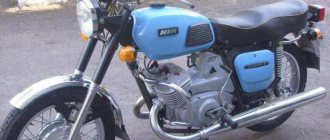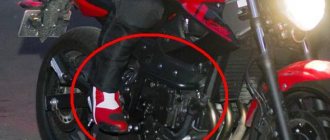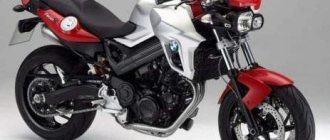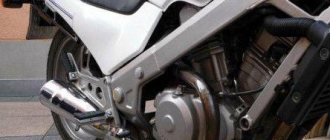The Italian motorcycle Aprilia Pegaso 650 is considered a legend of the Italian automobile industry. His power, grace and speed have conquered more than one freedom-loving heart. In character, he is similar to the inhabitants of Italy themselves: synonymous with limitless travel, fun adventures and trips along the most difficult routes. This road bike is a dream for those who spend half their lives on two wheels.
The history of the Italian "Pegasus"
Gone are the days when the demand for motorcycles was great due to the fact that few people could afford a full-fledged car. So we had to drive old Hondas and Javas. Nowadays, the cost of a decent two-wheeled friend can easily exceed the cost of a car. It becomes a luxury item, an outlet for residents of big cities.
We can say without unnecessary pathos that the Aprilia Pegaso 650 is exactly the kind of motorcycle that many people dream of. Therefore, it is not surprising that among motorcycle enthusiasts there are fans and collectors who are able to sell their souls for an excellent copy.
What is the story of the Aprilia Pegaso 650? The description can begin with the myths of Ancient Greece. The proud winged horse Pegasus, carrying his graceful body on two wings, has long been considered a symbol of power and freedom. Both heaven and earth are subject to him. The Italians made the “iron horse” the same way. Under the hood it carries a 650 cm3 engine, which allows it to accelerate to 165 km/h. With it you can get a real taste of adventure. On the versatile Aprilia Pegaso 650 you can go on a road trip or a trip around the city. With a sophisticated and bold design, it's more compliant on the road than many of its peers. The powerful and fast device responds to every movement, allowing you to go from leisurely driving to high-speed flight in a split second.
Test drive ApriliaPegaso 650 Strada
It's funny, but the best technology tests happen spontaneously.
It used to take weeks to gather people, equipment, and coordinate schedules. When, it would seem, everything is already “on the ointment,” His Majesty Chance intervenes, as a rule, not missing the opportunity to throw a hefty scoop of ointment into a spoonful of honey. It’s different when the opportunity to test a long-desired device literally falls out of the blue!
In my little black notebook, a list of motorcycles has long been collecting dust; if I didn’t test them, I would be in excruciating pain for wasted years. The Aprilia Pegaso Strada is also included in this list, and it is far from in last place. Several photographs of this masterpiece of Italian design have long taken up space on my desk, on my computer screen. And the girl is already looking at me askance, in my opinion, compliments on Italian bikes are heard more often than on hers (I’m ashamed, I’ll correct myself!).
And so a call to the editor, they say, so and so, 'would you like to test the Pegaso 650 Strada...
They're still asking! I never intended to do it this fast. Moreover, the path from Leo Tolstoy Square to Zhulyany Airport, next to which the dealership of Italian motorcycles is located, was covered in traffic jams in about twenty minutes (there was something heroic in the way DRIVE and I made our way through the tightly packed rows of tin cans, but more on that another time).
A bright, red-orange bike stood in the sunshine and exuded positive energy, physically tangible. I’ll say right away that this test drive will most likely be biased, because it’s simply impossible to stand with a sour face, looking for assembly flaws and design flaws of this beauty! Take a look at the sleek fairing with crystal headlight mounted on a silver subframe that is a work of art in itself. The soft, flowing lines of the false tank go into the graceful “waist” of the seat, and then... beyond the mouth of the “heavy guns,” that is, mufflers (lovers of ladies who adhere to the “military” style will definitely like it). Miniature LED turn signals look like they were taken from a catalog of tuning accessories, and wheels with Y-shaped spokes (exactly the same as on the RSV1000 superbike), painted in a rich blue color, are successfully combined with the “carrot” body kit.
In the saddle of the Aprilia Pegaso 650 Strada you feel with maximum comfort. The width, shape of the cushion, and most importantly - 780 mm of seat height, allow a driver of almost any height to feel confident in handling a motorcycle with a fairly high center of gravity.
The dashboard amazes with its abundance of functions with its overall external compactness. Everything is clear with the analog tachometer, but it’s worth talking about the electronic service system in more detail. When the ignition is turned on, the on-board computer fully tests the motorcycle's systems and only then makes it possible to start the engine. In addition to speed, daily and total mileage, an extensive menu is displayed on the LCD monitor, in which we found a lot of interesting things. Firstly, you can choose a menu in one of five European languages (neither Russian nor Ukrainian is on the list, of course). Next comes the service menu, which, if necessary, is activated by mechanics by entering an individual code. As for “fun” for the owner, you can set the number of engine revolutions at which the blinker will flash, signaling the need to change gear. Moreover, when going out on the track (you remember that this is a supermoto, although it’s pretty “haired”?), you can use the lap counter, which, in addition to the lap time, records the maximum/average speed and total time. Please note that all this “richness” comes “as standard” on the company’s far from the most extreme motorcycle!
The elaboration of individual elements is simply amazing. How do you like, for example, a box for maps and documents, located in the false tank and opened electrically by pressing a button on the left handlebar? Or a starter button that doubles as an ignition disabler...
We can talk about the details for a very long time, and I already foresee the public’s indignation about the too long “introductory” part.
Well, a few agonizing seconds of testing the systems, and now the “green” light has been received. Another moment, and a 659 cc heart woke up under me. Bang-bang-bang! The sound is rough and powerful. Thanks to the balance shaft, the operation of the huge “pot” does not cause shaking of the insides, but it categorically declares the harsh nature of the engine. The first turns on softly, with a clear fixation. It immediately becomes clear that Aprilia does not respect the “super-bottoms”. Up to 3000 rpm. the engine seems to be sleeping and even sometimes seems to be “choking”, asking for either a lower gear or more revolutions, but once you cross this line, a completely different side of the character will be revealed to you: explosive, mischievous. The engine, equipped with an electronic fuel injection system, instantly responds to the movement of the throttle. In the first three gears, Pegaso “goats” from the handle, and if you act less radically, it pleases with excellent acceleration. You fly through all five gears in one breath (thanks to the clear gearbox). At maximum speeds (for this Aprilia it is approximately 170 km/h) the bike behaves well, but after the mark of 130 km/h the oncoming air flow begins to be very annoying. But within reasonable speed limits, you can enjoy acceleration and excellent maneuverability, which makes slalom in traffic a relaxed and enjoyable experience. Fifty horsepower produced by the Rotax engine is enough for any situation that a modern metropolis can offer, and even the considerable (for a motorcycle that claims to be a “civilian”, but motard) dry weight of the motorcycle, equal to 168 kg, is not a hindrance to it .
At the front, the Aprilia Pegaso 650 Strada has a 45mm fork with 140mm wheel travel. At the rear there is a steel swingarm with a Sachs monoshock absorber and the proprietary APS linkage system (wheel travel 130 mm). Frankly speaking, such a small suspension travel caused legitimate concerns at first, since it is only 20/10 mm (front/rear) more than, say, a Yamaha R6. In fact, the fears turned out to be in vain. The characteristics of the suspension are such that any city bumps are handled with a bang, with the caveat that the motorcycle goes down the road like a glove. Speed bumps give way under the pressure of the Italian bike, you can pass them even with a good move, even on the rear wheel... Although, what am I talking about? We are kind, and we don’t even saw the footpegs on the asphalt (although, if the motorcycle had been broken in, believe me...). Considering the chassis characteristics, as well as the fact that the motorcycle is equipped with Pirelli Diablo tires as standard, there is no doubt about Pegaso’s ability to respond to “harassment”. But the frame does not quite share our passion: at a good speed, in a turn with an imperfect surface, it begins to “whisper”, and the accuracy of following the trajectory decreases. Make it tougher!
Impressed by the brakes. Although there is only one disc, its diameter is 320 mm, and it is paired with a four-piston (!) Brembo caliper. The slowdown is truly impressive, you can't even dream of two disks.
In general, riding the Pegso Strada is a fountain of emotions, and exclusively positive ones. The ergonomics of the driver's seat, the engine (after 3000 rpm), the chassis (in medium-hard modes) and the brakes deserve praise. But, alas, there are also disadvantages. First of all, this is the location of the radiator, which at the first more or less serious fall (no matter on which side) will deal a blow to your budget. There is only one way out (even if you are not an extreme sports enthusiast) - installing radiator protection. It is also better to replace the plastic engine protection with a metal one, since an unsuccessful attack on a curb can lead to unpleasant consequences. The same applies to wheel rims. Their design is excellent, and their functionality in normal modes is not satisfactory, but they are completely unsuitable for road hooliganism; splitting them (during an aggressive attack on curbs) is a piece of cake. If you intend to calmly drive from point A to point B, then there is only one mandatory item left for you - protection for the radiator. It’s strange, but for several hours in a row I didn’t part with the bike, and the excitement didn’t even think about drying up! Returning the keys to the salon employee, for a long time I felt internal vibration and a strange devastation that happens after a powerful emotional outburst.
Is this an extreme motorcycle? Probably not. On the other hand, this is the most aggressive and “lively” civilian supermoto I have ever seen. The line between its practicality and emotionality is so thin that the situation when you are calmly driving around delighted with yourself and the fact that not only an anti-theft cable fits into the trunk under the saddle, but also a raincoat, and some small things, maybe in a minute turn into overtaking a street driver or a road worker along the outer radius on asphalt whose condition is far from ideal. Its design speaks for itself, the attention to detail is pleasantly surprising, and technical solutions such as the oil tank in the frame or the ultra-functional on-board computer are delightful. Of course, the Aprilia Pegaso 650 Strada is not without its shortcomings, sometimes serious ones (I’m talking about the radiator and frame), but... Personally, I would easily forgive them, because you vote for this motorcycle first of all according to your heart, and secondarily - mind.
The Italian motorcycle is an irrational category by default, so don’t blame me, I’m in love again. The object of attraction is the Aprilia Pegaso 650 Strada.
Text: Denis Los
Photo: michel
Style
The appearance of Aprilia motorcycles will surprise even the most refined taste. Narrow front part, plastic that seems to flow around the parts. It is unlikely that the “Italian” will leave people passing by indifferent. On the front is a logo in the form of a winged Pegasus, the company’s symbol. The eye-catching front end of the motorcycle is equipped with a stylish headlight that fits perfectly into the overall concept.
Engine
Aprilia motorcycles have a powerful engine that deserves special praise. Having the largest engine capacity among its class, it satisfies the needs of fans of “universal” equipment. Great for the city. But if you want a little extreme, “Pegasus” will also take on moderate off-road terrain. Quality has always been the main distinguishing feature of the Aprilia Pegaso 650. Spare parts from the Italian motorcycle concern are manufactured to the highest standards, capable of surprising even experienced drivers.
In the Pegasus line, marked with the number “650,” there are several models, each of which is designed for different conditions.
Aprilia
Aprilia has come a long way with the Pegaso 650 motorcycle, over the years the model range has been expanded with two modifications, Factory and Trail.
Both are as similar as they are different. The first one belongs to the motard category, and the second one is enduro. The above confirms the talent of the Italian Aprilia masters to transform one motorcycle into something completely different. Like all Aprilia motorcycles with the "Factory" prefix in their name, the Pegaso 650 Factory is the fastest and best Pegaso of them all. It has better performance, lighter materials and of course the latest Aprilia technology.
Pegaso Factory Features: • Alloy spoked wheels • Front brake with radial calipers • Radial master cylinder • Increased seat height for better control • A range of carbon fiber components
Even though the Factory is powered by the same 650cc single-cylinder engine as the standard Pegaso 650, the bike is faster and more aggressive thanks to its lighter chassis.
In the history of motorcycle building there has never been a more appropriate name for a motorcycle than Pegasus. In one of the Greek legends, Pegasus was the name of a winged horse, a symbol of power and freedom.
The Pegaso Trail model expands the range of the Pegaso line, which has existed for more than 12 years. The motorcycle is definitely one of the best in the 650 cc enduro category.
Thanks to its incredibly good steering angle (70°, 35° + 35°), the Pegaso Trail copes well with city traffic and is suitable for daily driving. The motorcycle is very versatile, it can also be successfully used off-road, as well as for long trips, since the windshield is adjustable in two positions and the motorcycle is extremely comfortable.
Technical characteristics of Aprilia Pegaso 650 Factory / Trail 2010:
• Engine: single cylinder, four stroke, lightweight, liquid cooled, SOHC, • Fuel: unleaded gasoline. • Bore x Stroke: 100 x 84 mm • Volume: 660 cm3 • Compression ratio: 10:1 • Maximum power: 48 hp. (35 kW) at 6,000 rpm • Maximum torque: 6.01 kgm (59 Nm) at 5,000 rpm • Fuel system: injector • Ignition: electronic • Start: electric • Generator: 290 W • Lubrication: dry sump with oil pump • Gearbox: 5 speeds • Clutch: multi-plate in an oil bath • Final drive: chain. Gear ratio: 15/44. • Frame: steel • Front suspension: 45 mm fork, travel - 140 mm / 170 mm. • Rear suspension: swingarm, Sachs hydraulic monoshock, -130 mm / 170 mm travel • Front brake: 320 mm stainless steel disc, 4-piston caliper • Rear brake: 240 mm disc, 2-piston caliper • Wheels: 3.50 x 17 ″ and 4.50 x 17″ / 2.15 x 19″ and 3.00 x 17″ • Tires: 110/70-17 and: 160/60-17 / 100/90-19 and 130/80-17
• Overall length: 2,173 mm • Overall width: 810 mm • Ground clearance: 250 mm • Seat height: 780 mm • Wheelbase: 1,479 mm
• Length: 2,232 mm • Width: 820 mm • Ground clearance: 270 mm • Seat height: 820 mm • Wheelbase: 1,510 mm
• Fuel tank capacity: 16 liters
Photo of Aprilia Pegaso 650 Factory 2010
Aprilia Pegaso 650 Trail 2010 photo
Video Aprilia Pegaso 650 Factory / Trail 2010
Pegaso 650 Trail
The first road version was released 12 years ago. By re-releasing and updating the model range, the manufacturer has not changed the main thing: its versatility. Available for both on-road and off-road travel, the Aprilia Pegaso 650 Trail is at its best on long touring trips.
But there are also many innovations in it. Despite the single-cylinder engine, figures reach 50 horsepower already at 6250 rpm. This is impressive power for such an engine. Fantastic torque helps you overcome off-road conditions and obstacles that arise on it.
Aprilia Pegaso 650 Trail is not in vain designed specifically for active off-road driving. Powerful spoked wheels, excellent tires, a 4-valve engine with a dry sump, and 44 mm throttle valves allow it to be a real ace on touring trips. For driver comfort, the motorcycle is equipped with a windshield and a comfortable seat. The large 70-degree turning angle makes it easy to maneuver through streets and traffic jams.
care not only about the owners of the motorcycle, but also about the environment. The new catalytic converter in the exhaust system minimizes the release of harmful gases into the atmosphere and complies with the latest European standards.
The chassis needs to be mentioned separately: in this model it has reached almost perfection. The frame is surprisingly light, but at the same time very rigid. Such characteristics ideally meet the needs of the enduro class, allowing them to withstand difficult travel conditions.
The suspension of the new Pegaso 650 Trail was also not ignored. Featuring the thickest fork stays of any road bike (45mm), it absorbs road imperfections effectively, allowing its rider to feel the most comfortable. The front wheel travel is 170 mm, which achieves an excellent balance between braking and handling of the motorcycle.
The Aprilia motorcycle concern continues to adhere to the golden rules of manufacturing road motorcycles - a 19-inch aluminum front wheel was chosen for the Trail model. And the gas-filled rear monoshock seems to be designed to complement it. All together provides comfort and excellent handling on dirt roads. So, no matter how hard you try to lead this iron horse badly, you are unlikely to succeed.
So, I’ll tell you how and why I purchased a rather rare Aprilia Pegaso 650. What surprises it presented during the 4 years of ownership, what improvements were made. For those interested, please follow the cut! I’ll start, as it should be from the very beginning, with an awareness of the need for a tourenduro. It all started with owning a Kawasaki Eliminator. My first moto... Everything a beginner, brought up on heavy music and films about bikers, needs. Black, looks like a classic American motorcycle, and with 4 pots, 4 carbs and 53 horses, it's straight up (for the first moto). What else does! In the end it turned out that there were a lot of things! Having ridden along our roads, especially dirt roads, I realized that I don’t have enough degrees of freedom on this motorcycle, I want more cross-country ability, no, not into the forest and shit, but just on roads, bad, but roads. Anyone who has ever visited a Kawasaki ZL forum knows that the largest thread is dedicated to carbs. And this is a real disaster, especially when coupled with the quality of the road surface. Even if you washed, synchronized the carbs, and everything worked, on the first bump, the air box pipes, which have dried out over time, treacherously jump off the carbs, the idle disappears and everything starts again. And yes, the moto is rushing, but at the same time it eats, even on the highway, plus a small tank. This was especially frustrating when traveling in Europe due to the price of gas. In principle, it’s even possible to place a passenger and luggage on the Lum, but leaving the bike somewhere unattended is scary, since everything is in bags or tied with ties. And naturally there was not enough wind protection. Of course, having a great desire to go somewhere, I successfully traveled, as it seemed to me at that time, long-distance trips and was finally convinced that this was for me. Drive around the city or stupidly stand on the V.O. arrow. it’s not mine, it’s a distant one - yes! Well, another problem has arisen, I understand with my head that the speed limit was invented for a reason, but it’s difficult to get rid of the temptation to turn it all the way down. As a result, the following criteria were formulated: - we are definitely looking for a tourenduro - the more panniers in the set, the better - good wind protection - the simplest possible design so that you can sort it out in any village, well, fewer pots, fewer problems with carbs))) - large tank + low consumption - well, the budget for everything is around 150tr at the time of 2014
These requirements included: with a big stretch, Transalp, Kava KLE, Suzuki Freewind XF650 and Pegso itself, and also from BMW under the number F650. Transalp was dropped due to the high cost of sane samples, and they were “naked” in terms of body kit. KLE - Kawaskie, private soldier, I didn’t want to get involved in all this again. Freewind simply wasn’t in St. Petersburg at that time, well, the air vent was a little annoying. Pegasus and BMW remained the method of elimination. The differences are minimal, in favor of the BMW there are 2 spark plugs and 4 valves in the head, in contrast to the 5 valves of the Pegasus, in favor of the Pegasus the design and price, which played a decisive role.
So, the decision has been made, let's go looking... And again the agony of choice! Pegasi from different years are structurally different! I did not consider the first years of production. And I was choosing between the end of the last century and the beginning of this one. What is the point?! Since 2001, these motorcycles began to be equipped with an injector, and the upside-down fork was replaced with a telescopic one, plus minor differences, including a reduction in tank volume. A separate thread on the forum is devoted to this topic. Having suffered with carbs on the Lume, the first push was towards more recent motors, but after thinking a little, reading the forum and not finding any complaints about the carbs, I remembered reliability as a selection criterion. You can sort out the carbs in the field, but the fuel pump suddenly lights up. I also really wanted a reversible fork (as it turned out in vain). The choice has been made, and in my dreams I already own a small tourenduro with an Austrian Rotex engine with a dry sump, an inverted Marzocci fork, Brembo brakes, a stock luggage rack, a 22-liter plastic tank and low fuel consumption, and ideally with a full set of panniers and a central stand . There were no problems finding a moto in St. Petersburg, not in the sense that the market was flooded with excellent offers... Quite the contrary, there were literally a couple of options, of which there was only one within my budget and the desired year of manufacture. That's what I went to see. The first thing that attracts your attention is that the motorcycle is painted completely in bright yellow with airbrushing. And it was November 2014... The motorcycle was in winter storage at a motorcycle service center in Vaska. So we didn't get to ride. They have already said 100 times that no matter how much you want to take a motorbike, you need to look carefully, but as always, due to emotions, I overlooked a few points... They started it up, measured the voltage, because... The relay-regulator was changed by the previous owner, externally inspected, nothing is leaking anywhere, the set includes 2 side cases, there is an enlarged windshield, everything you need. The exchange rate was rising, the prospect of bringing something from Europe was fading before our eyes, there were almost no other options in St. Petersburg (although I don’t know why I didn’t look at another one). They shook hands, and now I am the owner of an Italian motorcycle!
I had grandiose plans for the motorcycle! This is a trip, at the very least you need to travel around the whole world, and perhaps go to Mars with Elon... We are starting to prepare... The central case has been ordered, the Starline alarm system will be delivered tomorrow, all the liquids need to be changed. I take off the plastic and... and the first joke is that the radiator is moving strangely, how did I not notice it! The lower mounting points are broken, the radiator shakes on every bump. Trouble, what can we do, we go online, we found the radiator quickly enough, though it’s from a BMW F650, oh well, it should fit (spoiler: how wrong I was), the fasteners are in place, let’s take it! There were no problems with the oil, the filter was available in St. Petersburg, it came to the brakes... in the back no problem, in the front... one more nuance, but it was impossible to notice: the membrane had swollen over time, and even had holes in it, something to farm, glue in the brakes Not an option at all, a replacement! the problem is not that delivery from the USA or Europe, the winter is long, the problem is that this elastic band was not sold separately, only with a lid, and this is of course more expensive, but what to do, I ordered... We move on, taught by bitter experience with Lum, I climbed into the carbs, everything was tolerable, I washed it, yes, there are 2 carbs and 2 exhaust pipes per cylinder, but there is no need to synchronize them, but there was a problem with the rubber inlet pipe... one of them was glued. It’s no good, it breathes just fine, it’s due for replacement... taking into account fluids and spare parts with delivery at the time of 2014, I had to spend about 10tr on everything, the spare parts have arrived, it’s time to collect. And then I discovered my mistake with the radiator, no, the mounting points, the diameter of the pipes, everything fits, but there is no hole for the fan sensor in the radiator housing! How is that! I open the BMW diagram and discover that the sensor is not located in the radiator, but actually at the outlet of the engine in the pipe... well, it’s time for the collective farm, we just have to decide what exactly we’re going to rush, solder the legs to the radiator or somehow attach the sensor to the pipe. I didn’t solder the radiator for 2 reasons: few people undertake it, it’s expensive, there are no guarantees that the radiator won’t get clogged, firstly, and secondly, due to the lack of a protective grille in front of the radiator, it was not in the best condition, compared to purchased from BMW. Well, let's go to a plumbing store and look for a T-shaped pipe the size of the pipe with a thread for the sensor. The spare part turned out to be almost original, with the inscription made in Italy :-D. It seems that we have sorted out the technical part and are preparing for the trip. A central 42-liter Shad case, an alarm system, a cigarette lighter, or rather 2, were installed on the stock platform, one on the dashboard with a voltmeter, the second under the saddle for the passenger and charging gadgets in the cases. Taking into account previous experience, I immediately installed heated grips. And in the summer of 2015 I went on 2 long-distance trips. First in the Baltic states, but more on that later, and near Tver for the Invasion. According to the stories of forum members, the weak point of the motorcycle is the head gasket, so I bought it in reserve in the Baltics so as not to pay for delivery later, although the previous owner said that he had already changed the gasket somewhere around 30 thousand km, I got the motorcycle at 35 thousand km. . As a result of a trip to Nashestvo (thanks to Tver roads), the fork seal leaked. And then the epic began... no questions, we change the oil seals, the motor is not new, it doesn’t happen to anyone, naturally we change both, everything is fine, we set it up for the winter. Spring 2016, I’m going to Belarus for the May holidays, visiting relatives, going for a ride. Again 25, the oil seal is snotty! I come back, go to the forum, they recommend changing the guides, it’s the height of the season, we have to wait about a month for spare parts, we order, but driving like that is not an option, the oil is pouring directly onto the disc. We restore the guides by baking them in the oven after coating them with MS 2000. It didn’t last long, but it was enough until new ones arrived. The fork is disassembled once, we install new guides, seals and the whole of 2021 without problems. It feels like... It’s certainly strange to compare with an in-line scabies, but I don’t really have anything else))) On the pleasant side, it doesn’t eat much, on the highway it’s around 5 liters 95, wind protection for the hands is generally a thing, the enlarged windshield is an ambiguous thing, it cuts off the flow very strangely straight into the helmet, already in 2017 I installed a small deflector, it became much better. From the unpleasant, or rather from the unusual - the chain))) With the cardan it was easier... right there every 500 km, be kind, and the second point - vibrations, no, the driver is basically fine, but the passenger was not very comfortable, especially on the pegs. Brakes, they are there! Naturally, a single-barreled gun is not as fast as an in-line four-gun, but at the same time it drives from the bottom, and there’s no point in pushing it, you’re driving calmly along the highway at 5t. rpm It swallows potholes on the road in one go, although you can’t fix it up to the running boards. Regarding protection... when Lum fell at almost 0 speed in the garage, the turn signals immediately flew off, on Pegasus he fell only once, in 2015, on the way from Invasion, I pulled over to the side of the road, I braked, there was 1 disc on the front wheel, it pinched... the fork tucks in to the left... result: we are lying on the ground, it’s not pleasant, fortunately the speed was low, because By that time I had slowed down to about 35 km/h. Both are alive, a couple of abrasions, the moth got off the same, scratches on the muzzle. everything... the rest was worked out by the steering weight and the rear case, again the roadside is softer than asphalt. We picked up the bike and moved on. Another problem with falls is that the moto has a high center of gravity and all these motos have padded handlebar weights and burrs, because. It falls from the side stand on a minimally uneven surface, so I put it on the center stand. Apart from problems with fork seals and valve adjustment, 2021 was not marked by anything. In addition to the trip to Belarus, I traditionally went to the Invasion; there was not much time for long-distance travellers. 2021 is the year of the big trip! And accordingly, preparation for it! Once again, having read horror stories about broken gaskets on the forum, realizing that I had a new spare one, and the previous owner may or may not have changed it, I decided to remove the engine, carry out an inspection and replace the gasket. Fortunately, the engine is small, you throw it in the trunk and take it home, where you can dig around in the cold winter in warmth and comfort with a cup of cocoa. As a result, the valves were adjusted normally, the clutch basket was inspected, the head gasket was replaced with a new original one, the head bolts were tightened again, because The gasket tends to shrink a little after the first pull. IMPORTANT! don’t get into the engine without a torque wrench, believe me, it won’t end well, the thing is not the most expensive and will come in handy around the house, or borrow it from someone. All tightening torques are in the manual. Traditionally, I visited Nashestvo, but this is no longer serious: 1500 km in total, plus around the city, but ahead... Finland-Sweden-Norway! We change the oil after 4000 km, because... There is still the same amount of time ahead, and the service interval is 6t.km. Among the modifications to the motorcycle, two bags were made from old jeans for the tank for raincoats, lubricants, etc., because the trunks were filled with things + a tent. I replaced the oil pressure sensor, the price is 200 rubles, apparently in 15-17 year old motorbikes it is already arriving, as well as the rear brake frog, which was also replaced for 150 rubles, judging by the forum, both sensors are dying en masse by this time, so if anyone I've set my sights on buying a conic, look at these things. Finally I installed an aluminum protective mesh in front of the radiator. I made a mudguard for the front fender, again to protect the radiator. Two tubes for tools and first aid kits for the side cases were made from 2 fan pipes. This was my first trip in the mountains, and there are no complaints here either, the brakes and traction are enough for a loaded motorcycle with a passenger. During the trip a problem arose - the steering bearings were knocking... we got home, where they replaced both. And the most interesting design feature of the motorcycle is the exhaust; both manifold pipes run along the right leg and under the driver’s saddle, warming up the seat very well. So the heated seats are not switched off in stock))) In our northern realities, this is more of a plus than a minus, especially in the rain, in the mountains in Norway, when there is snow on the roadsides in August. The exhaust, like all old motors, begins to rot, namely the cans, because... They are painted and everything from under the wheels flies on them all the time. I painted it with thermal paint as a preventive measure and it's holding up for now.
I think that many people are concerned about the question: what about off-road?! No way, I don’t know, I can’t do it, and that’s not what a motorcycle is about. Into the forest on a dry road on a dirt road without any problems, on gravel roads in Estonia - it’s easy! But in the mud, my tires are not the right ones... And I don’t have the skill. Although right there on BikePost there is a blog about forest rides on Pegasus.
Instead of a conclusion: The motor as a whole fully meets my expectations, reliable, simple, bright, rare, stands out in the crowd, there are no problems with consumables, there are nuances with spare parts, in fairness I note that the old Kava had the same story. For traveling alone - excellent, for traveling with two... suitable with a certain level of comfort. I’m glad about this acquisition, but like any of us, I’m looking at something else... and I come to the conclusion that from the combination of tourenduro, I’m more interested in touring, since the roads in Leningrad are not so bad, but I’m silent about Europe... we’ll see.
Z.Y.: I have a neighbor in the garage, and he has an indestructible Japanese quality 600 Transalp... And from him I constantly hear that Italians are not reliable, you are constantly digging into it, look at the Honda, it is reliable, just change the oil once per season, even if you run 10t.km per season. so what if there’s no piece of plastic and the speedometer doesn’t work, it just keeps going... So, I’m not very happy with such reliability, and I don’t want to rely on chance on a long trip, that’s why I’m digging, although all this may be unnecessary, and I could ride it without doing anything at all, but I can’t ride a faulty motorcycle!
Pegaso 650 Strada
Unlike the previous model, the first thing that catches your eye when looking at the Strada is its design. Bright, even a little aggressive, it will not go unnoticed by those who ride it. The orange plastic parts and the blue painted wheels go well together. The production of this model began back in 2005. The Strada features a five-speed gearbox and a chain drive, which allows for better control of the movement.
The Aprilia Pegaso 650 Strada, even in this configuration, has not changed its main feature - a 4-stroke engine with one cylinder and four valves, equipped with liquid cooling. Powerful and fast – that’s what has become synonymous with motorcycles from the Italian automobile industry.
The Strada is equipped with a fuel injection system with a 44 mm throttle body. Under the hood beats a 659 cc heart, capable of accelerating to 170 km/h. The engine, equipped with an electronic fuel injection system, is very sensitive to any hand movement. This suggests that it will be difficult for a beginner. But a professional driver will be able to fully enjoy the agility of his two-wheeled friend.
The enduro seat will help you endure even a long journey in comfort, it is so comfortable. 780 mm seat height allows even tall people to easily cope with obstacles on the way, because provide a high center of gravity. Motorcycle saddlebags, which can be mounted on various parts of the motorcycle, provide high storage capacity. If necessary, you can take all the necessary things on the road.
The basic package includes Pirelli Diablo tires, long known for their quality. But the braking system is beyond praise. The diameter of the brake disc is 320 mm, and it is accompanied by a four-piston Brembo caliper. Braking occurs on time, smoothly and reliably. Is it worth dreaming big?
And although this motorcycle model cannot be called extreme, capable of various road tricks, it occupies its own special niche in the market. A road bike that is pleasant to look at and pleasant to ride will appeal to those who choose their transport not only with their minds, but also with their hearts.
Typical disadvantages
Aprilia therefore decided to make a few adjustments and the new model hit the road in 1995. Changes included an inverted front suspension, replacing the stiff and leaking rear shock absorber (which was repaired under warranty) - it was replaced with a better tuned one with adjustable rebound damping. The new model also had a more comfortable and 3cm lower seat - the previous one, located at 870mm, was a problem for shorter riders. A frequently occurring malfunction was also eliminated: a jammed coolant pump shaft. Unfortunately, some shortcomings remain. The second generation Aprilia Pegaso continued to fall with a slight fluctuation above 130 km/h, the headlight was still poor and access to the crane was difficult. Nothing was done about the big drawback of the engine, that is, its gluttony. He still managed to drink 8 liters of gasoline per 100, which with a 14-liter tank is a bit contrary to the idea of a touring enduro.
Aprilia Pegaso 650
In 1997, another version appeared, which was more "adventure" than "enduro". The fairing was now larger and provided better wind protection, and the dual reflector installed in it finally illuminated the road properly. The motorcycle had a longer wheelbase, which excluded the mention of a “snake”. Instead of a “cross” in appearance, the seat was given a more comfortable one (especially for the passenger), graduated and - more importantly - placed at the same decent height of 840 mm. In addition, the tank now holds 22 liters of fuel, which has significantly improved range, and the engine thanks to a new valve timing system, a new airbox with a more frequently replaced air filter cartridge and more efficient mufflers providing work culture and flexibility below 3000 rpm .
But Aprilia did not rest on her laurels. In 1999, a version called Garda was released, which was full of tourism. It had adjustable hydraulic rear suspension spring preload and came standard with a rack and side trunks and finally a center stand. However, you had to shell out extra money for it. At the initial stage of production, only silver-coated varnish could be purchased.
Another change was the introduction in 2004 of a slightly (but only slightly) sportier version called the Tuscany Tibet Raid. The bike featured a lot of glass, longer suspension arms, and a standard box-shaped aluminum body. Unfortunately, due to all the changes to the engine that required the reduction of exhaust emissions imposed by Euro standards, it has clearly lost the will to hit the market until now. The company still claims 48 hp.
In the 2001 season, both versions of the Pegaso remained unfinished. The engines now have a fuel injection system. The Sagem electronic injection system with one nozzle per intake port and a new air filter housing have certainly improved the uniformity of power delivery. The Pegaso also had a catalytic converter, but unlike the BMW F 650 (which received fuel injection also in 2001) without a lambda sensor. In addition, the previous inverted front suspension has been replaced by a classic Marzocchi fork, but without adjustment. The latest change was likely aimed at reducing production costs. The Garda version can also be purchased in the upper price segment.
A year later, big changes took place. The Rotax engine was replaced by a more modern liquid-cooled 659 cc engine, copied almost unchanged from the Yamaha XT 660. There were two mufflers and the engine developed 50 hp. (Yamaha has 48 hp). The bike was also taught to ride on the road, so the new version of the Pegaso was almost entirely a road machine, earning it the nickname Strada. The chassis has also been completely changed. The conventional steel frame with a massive central beam now used the engine as a load-bearing element. The front fork, with 45mm shanks, had 140mm of travel, while the rear Sachs center shock with adjustable spring preload and rebound damping had 130mm of travel. At the front, a special (320 mm) brake disc was used, which was bitten by a Brembo clamp. The tank had a capacity of 16 liters and the motorcycle was equipped with a small fairing. The list of additional equipment includes ABS, heated steering wheel and trunk. The Aprilia Pegaso Strada could be purchased with two upholstered sofas, the height of which was 780 or 810 mm above the ground. Work began immediately on a more off-road model.
The more road-friendly Strada motorcycle appeared in 2006 and was named Trail (meaning path), which explains a lot. This is not an enduro, but a machine for easy terrain. It has spoked wheels (cast in the Strada) with diameters of 19 inches at the front and 17 inches at the rear. In the front suspension the travel was increased to 170 mm, and in the rear also to this value. The brake disc has been reduced to 300mm using a two-piston brake caliper rather than the Strada's four-piston brake.
Aprilia Pegaso 650
Aprilia Pegaso 650 Cube
This model, like the previous two, is an alternative compromise for city trips and occasional off-road trips. On a paved route it will be maneuverable, fast and powerful, but it may not be able to handle strong mud. It’s just that the rough terrain at the entrances to villages and towns is easy to handle. If you are looking for a motorcycle specifically for such conditions, we recommend taking a closer look at the “Cuban”.
Its main characteristics do not differ from its counterparts discussed above. Still the same 659 cc engine with 1 cylinder. It maintains a good ride at speeds of about 100-150 km/h, but can accelerate to 165 km. Depending on the type of engine, there are injection and carburetor engines. The steel support serves as a reliable off-road companion.
The main difference is the appearance of the motorcycle. If the Aprilia Trail is made in restrained dark colors, and the Strada is made in defiantly bright ones, the Pegaso 650 Cube exposes its silver sides to the sun. On the front of the plastic there is a logo in the form of the model’s symbol – a winged pegasus.
Model options
is world renowned and maintains its reputation by using only the highest quality parts. Therefore, Italian-made motorcycles satisfy even the most demanding customers. In the basic configuration you can find everything you need for comfortable trips.
The instrument panel is ergonomic and striking in its vastness. The menu, compiled in five languages, allows you to control not only the interface, but also the technical characteristics of the motorcycle. For example, if desired, you can adjust the number of engine revolutions.
Keeping in mind that this is still a “serious” motorcycle, you can set up a lap counter that will show the speed and time of laps. Not the most necessary feature, but certainly nice. Also noteworthy for the user:
- an immobilizer on which a PIN code can be set in case of loss of keys;
- gear shift thresholds (they can be set by the driver himself);
- as many as 2 compartments for accessories. The front one opens easily when you press a button, making it unnecessary to use keys. The compartment under the passenger seat is large enough to fit a lot of your personal items;
- windshield that can be installed in two different positions.
If desired, Aprilia can be equipped with additional parts.
- Motorcycle panniers for 28 and 45 liters are installed on the middle and tail sections.
- To protect the tank and store things, Aprilia is equipped with a cover and a bag made of high-strength textiles.
- The seat height can be increased by 40 mm.
- Carbon protection for the driver's hands and various enduro parts (engine, exhaust pipe).
- Advanced anti-theft system.
- Titanium muffler tip.
Comparison with competitors
The Aprilia Pegaso's main competitors on the market are the BMW F650, Suzuki XF 650 Freewind, Kawasaki KLR 650. Compared to them, the Pegasus wins in terms of price-quality ratio. The brand of the Italian automobile industry may not be as popular as, for example, BMW, but in terms of technical characteristics they are not much different. Reliable engine maintains stable speed. The design is also worthy of praise. Without overpaying for a big name, you get reliable transport that is not inferior to its big brothers in either engine size or speed.

